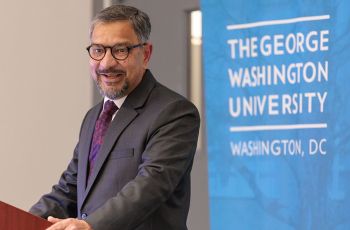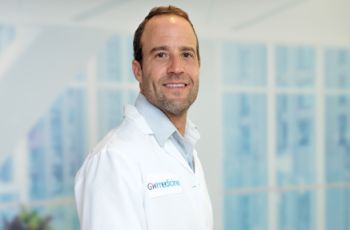With a six-year F99/K00 award from the National Cancer Institute, Trace Walker investigates how hidden regions of the genome — called transposable elements — could make ovarian tumors more visible to the immune system and open new doors for treatment.

You were recently awarded a major National Cancer Institute grant, the first of its kind ever received by someone at GW. What is the grant, how long does it last, and what does it cover?
That’s right, this is the first time the F99/K00 grant from the National Cancer Institute (NCI) has been awarded to someone at GW, which makes it even more exciting. The grant is designed to help early-career scientists transition from their doctoral research into postdoctoral training and, eventually, toward becoming independent investigators. It’s a six-year award: the F99 portion supports up to two years of my PhD work, and the K00 portion funds four years of postdoctoral research.
During my PhD phase, the grant covers part of my stipend, travel expenses, tuition, and institutional costs. The postdoctoral phase provides nearly full salary coverage and a small annual research allowance. It’s a big step toward independence — having my own funding means I can bring my own ideas to my next lab and begin developing them into long-term projects.
Could you give an overview of your research?
Sure. Our DNA has large “hidden” regions that can produce RNA sequences resembling viruses. These sequences, called transposable elements, can trick the cell into thinking it’s infected. When that happens, the immune system can be alerted to destroy the affected cells. My research looks at how cancer cells keep these viral-like sequences turned off, and what happens when they don’t.
I focus on a protein called p53, often referred to as the “guardian of the genome.” I’m studying how it can both activate and silence transposable elements. The big question is: how do cancer cells use this mechanism to stay under the immune system’s radar, and how can we turn that invisibility off?
You describe transposable elements as “hidden” parts of our DNA that can alert the immune system. How did you become interested in studying these silent regions, and what makes them so important in cancer research?
When you learn about genetics, most of the attention goes to genes — the small portion of DNA that codes for proteins. But that’s only about 2 percent of our entire genome. The remaining 98 percent was long ignored, and about half of that consists of transposable elements. I found it fascinating that such a massive part of our DNA was once written off as “junk.”
As I dug deeper, I realized these elements aren’t just silent passengers. They can regulate other genes, influence how DNA is structured inside the nucleus, and even spark immune responses. In cancer, they often lose their silencing, which can change how tumor cells behave and interact with the immune system. Understanding how they’re regulated is critical to understanding how cancer develops — and how we might make those cells more vulnerable to treatment.
Your work focuses on ovarian cancer and the p53 gene, which is often called the “guardian of the genome.” What have you discovered about how mutations in p53 change the way tumor cells behave or hide from the immune system?
In healthy cells, p53 acts as a protector. It helps regulate cell division and triggers cell death when there’s DNA damage, keeping growth under control. But when p53 is mutated, a common event in ovarian cancer, its normal function is disrupted.
What I’ve seen in my research is that mutations in p53 lead to major changes in which transposable elements get turned on. However, instead of triggering an immune alarm like we might expect, the response is muted. That suggests mutant p53 may actually give cancer cells a way to avoid detection, allowing them to grow unchecked. We’re still figuring out whether that’s a direct effect of how p53 binds DNA, or if it’s acting through other genes. Either way, it’s clear that mutant p53 helps create a kind of “stealth mode” for cancer cells.
You mention that activating transposable elements can make tumors more visible to the immune system. Could this lead to new treatment strategies, perhaps making existing immunotherapies work better for cancers that don’t usually respond?
That’s the hope. Immunotherapies work best when immune cells are already surrounding a tumor, but ovarian cancer and other “immune-cold” cancers often don’t have those cells nearby. If we can find a way to activate transposable elements, we might be able to draw immune cells into the tumor’s environment, essentially turning a “cold” tumor into a “hot” one.
Once those immune cells are in place, immunotherapies can help keep them active, preventing the tumor from switching them off. Combining both strategies could make treatments much more effective in cancers that haven’t historically responded to immune-based therapies.
In the second part of your study, you explore what happens when cancer cells move and spread. How might the physical stress of metastasis change what’s happening inside the cell, and why is that important for developing new therapies?
When cancer cells spread, they go through a physically demanding process. They have to squeeze through tight spaces, like blood vessel walls, and travel through the body to reach new sites. That movement puts enormous stress on their internal structure, especially on the cytoskeleton, which maintains the cell’s shape.
As these cells push and contort, their internal networks break apart and rebuild, leading to DNA damage and major changes in how genes are expressed. I think this mechanical stress may make cancer cells more aggressive or adaptable once they settle in a new location. Understanding how that stress rewires the cell could reveal new weak points — ways to target metastatic cells before they can establish new tumors.
Your research connects genetics, cell biology, and immunology in exciting ways. What do you hope this work will mean for patients in the long run, and how does being part of the GW Cancer Center support your goals?
My ultimate goal is to piece together a complete picture of how cancer evolves: genetically, physically, and immunologically. By connecting these areas, we can better understand how tumors grow, hide, and resist treatment. That understanding could lead to therapies that are more precise and effective, especially for cancers that are currently hard to treat.
The GW Cancer Center has been an ideal place for this kind of research. It’s a collaborative environment where experts in immunology, molecular biology, and genetics work side by side. That collaboration fuels creativity and innovation. It’s what allows big, complex questions like these to be tackled from every angle.
You work with Dr. Kate Chiappinelli as your mentor. How has that shaped your approach to science?
Kate is an incredible mentor. She leads with both rigor and compassion, reminding us that science is about persistence as much as precision. Not every experiment works, and that’s okay. Science is tricky, and it’s messy. What matters most is doing high-quality work that genuinely pushes the field forward. That mindset has taught me patience, resilience, and a deep respect for the process of discovery.
Any final thoughts?
Translating this work for a broader audience matters to me because it connects science back to people. At the end of the day, the goal is to make discoveries that improve lives. I’m excited to keep building on this research — one experiment, and one insight, at a time.



